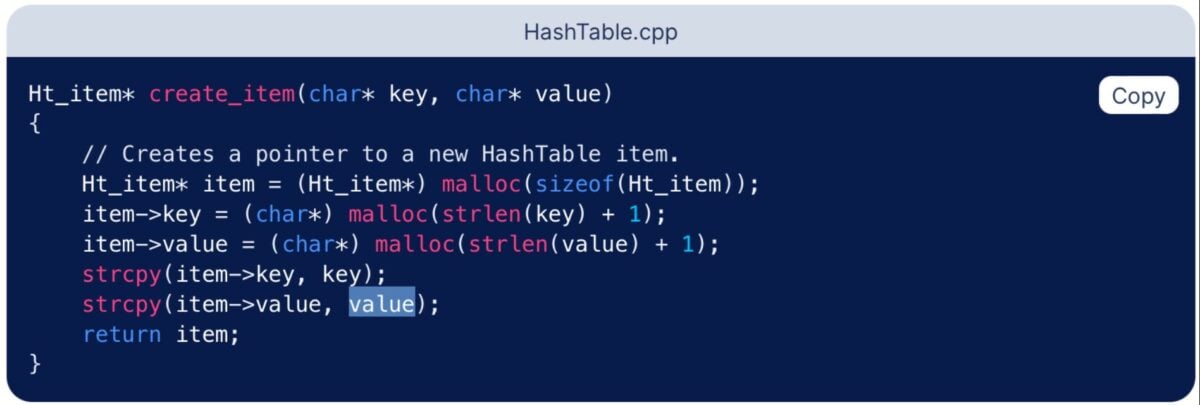So you’ve got a software engineering interview coming up. You’re probably a little intimidated at the prospect of having recruiters volleying questions at you rapidly and having to come up with answers under pressure.
Well, there’s good news for you. You can make life a lot easier for yourself by practicing the common questions that come up in software engineering interviews. Preparing for these will take a lot of the pressure off you and help you deliver answers more confidently.
In this article, we’ve covered twenty common software developer interview questions that you should prepare for if you aspire to work in this industry. We’ve also covered some key interview skills and techniques that you can use to impress hiring managers through different rounds of the interview process.
Technical Software Engineering Interview Questions
The following are some of the general technical software developer interview questions that you can expect to encounter in a software engineering interview.


Become a Software Engineer. Land a Job or Your Money Back.
Code in the industry's most widely used programming languages. Test your knowledge through job-ready projects. Work 1:1 with an industry mentor. Land a job — or your money back.
Can You Explain the Concept of “Continuous Integration” and Its Benefits?
Continuous integration is a practice within DevOps whereby the code that different developers write for a piece of software is uploaded to a central repository at regular intervals.
There is a technical component and a cultural component to continuous integration. The technical one refers to the tools and automation approaches that are used to channel code from each developer to the central repository. The culture component refers to the process by which developers are taught how to integrate their code and made to understand its importance.
There are several benefits to the practice of continuous integration. This includes:
Fault Isolation
Fault isolation is an approach in the development of software that strives to limit spillover effects when a fault occurs in a system. The approach of continuous integration supports fault isolation because it makes it easier to identify faults, ameliorate their effects, and monitor the system at large efficiently.
More Tractable Changes
Consider a situation where continuous integration is not used. In that case, you would have a system where large pieces of software are integrated after a long development phase. This would mean that a lot of debugging and repairs would have to be done at once. Continuous integration, on the other hand, makes it possible to deal with more manageable pieces of software that are easier to parse for bugs and other issues.
Accelerated Release Schedule
The result of the two aforementioned benefits is that software projects move at a faster rate when they employ a continuous integration test. This is because, when software is integrated in an easier fashion, faults are limited in scope, and it takes less time to resolve errors. Ultimately, this means that the piece of software gets shipped faster and with fewer major flaws.
Happier Customers
Besides the internal benefits of continuous integration, there’s also a customer-facing benefit, which is that customers enjoy faster updates and bug fixes thanks to this approach. You can use continuous integration to build new features and to quickly address any issues that your customers have been facing. That means that you’re able to create an actual product that’s able to keep up with advancing technological paradigms and customer feedback at the same time.
How Do You Ensure the Security of Your Code?
Ensuring code security is not just the domain of the cybersecurity professionals in an organization. Every developer can take certain steps to produce code that is safer and insulated from external attacks to an extent. Let’s take a look at what some of these steps are.
- Randomized Sessions IDs: Never produce session IDs that are based on a series or a predictable sequence of any sort. Also, make sure not to rely on changing just one variable in a session ID, as this makes it easier for hackers to infiltrate a system by using a brute-force approach.
- User Credential Criteria: Hackers will use various means to try to figure out user login credentials. To stave off these attacks, you should enforce rules for strong passwords and have an account lockout feature built into any login pages.
- Limited Error Code Information: You should write your error code text in such a way that users understand why a particular error code has occurred. But at the same time, you should not reveal so much that hackers are able to figure out some aspects of the inner workings of your software from the error code data.
- Take Advantage of Automation: You don’t necessarily have to build all of the security features for your software yourself. Make sure to be on the lookout for any tools that provide a plug-and-play option, which you can use to implement certain features.
- Document and Build Frameworks: Ultimately, code security is a practice that you need to be mindful of when you’re building software. You should document secure code-writing practices over time and produce a playbook that you can refer to whenever you need to as a developer. There are various documentation tools that you can use for that purpose.
Can You Describe the MVC (Model-View-Controller) Architecture?
The MVC approach is an architectural paradigm that separates every application into components called the model, view, and controller. Let’s first take a look at what each of these components consists of.
Model
All of the data logic for the system is handled by the model. This is the part of the architecture that interacts with a database and manipulates the data in it. The controller obtains any data that it requires via the model.
View
The view is the user-facing aspect of the MVC software architecture. The view component never interacts with the model directly. Rather, it takes data that is gathered in the model via the controller. This is how it generates user interfaces.
Controller
The controller is essentially an intermediary between the view and model in the system. It processes business logic coming in from the model and renders the output through an interaction with the view.
What Is the Difference Between a Library and a Framework?
Both frameworks and libraries are pieces of pre-written code. Where they differ is how those pieces of code are used.
A framework is a piece of pre-written code that serves as the foundation for the software development process. It includes any code within a programming language that developers tend to use repeatedly for different aspects of a software project.
A library, on the other hand, concerns itself with adding different functionalities or features to a program. They make it possible to quickly add code that performs a specific task relating to a feature that users will be able to use.
How Would You Handle a Situation Where a Project You’re Working on Is Behind Schedule?
Here are a few things that you can do to deal with a situation where a software project is lagging behind schedule.
Assess Causes of Delay
There are different reasons why your software engineering project might be behind schedule. The software project manager or scrum master (if your workplace uses an agile development approach) will be best positioned to make these assessments. However, you can, as an individual engineer, determine whether there are any issues in your personal productivity leading to delays in the project.
Talk to a Manager
If you feel like there are productivity issues that you’re running into in your personal work, you can talk to your manager to come up with solutions. They will be able to offer you these solutions based on their understanding of the project at large.
Be a Team Player
It’s possible that your project is behind schedule as a result of others in your team working slowly. If that’s the case, it’s an opportunity for you to help your team members out without judgment. You can talk to your colleagues to find out if there are ways in which you can support their work without falling back on your own responsibilities.
Algorithms and Data Structures Questions
Algorithms and data structures are areas in which every software engineer needs to be proficient. You’re going to be asked technical questions in this area in every software engineering interview. Let’s take a look at a few common questions that come up with regard to these topics.
Can You Explain the Concept of a Binary Search Tree?
A binary tree is a data structure constructed such that:
- Any subtree on the left has values that are lesser than the parent node
- Conversely, any subtree on the right has values that are greater than the parent node
- Subtrees to the left and right of a parent node should also follow the rules for a binary search tree
How Would You Implement a Hash Table?
Hash tables are sometimes also called hash maps. These are data structures that perform the function of mapping keys to their relevant values. This is achieved by putting together a chain of values in the form of a linked list where the keys correspond to a particular index.
The two main parts of a hash table in terms of the implementation are the hash function and the linked list to structure the table. Below is an example of code that you can use to create items in a hash table.

What Is the Time Complexity of a Merge Sort Algorithm?
The time complexity of a merge sort algorithm is O(N * log2N).
Can You Explain the Difference Between Depth-First and Breadth-First Search Algorithms?
There are four differences between depth-first search (DFS) and breadth-first search (BFS) algorithms.
- Data structure: BFS runs on the queue data structure, whereas DFS employs stacks.
- Construction: DFS is constructed subtree after subtree. BFS takes a level-by-level approach to constructing a tree.
- Application: BFS is better used when vertices are close to the source. DFS is more appropriate for vertices away from the source.
- Elimination of Nodes: Nodes are eliminated from the queue after multiple traversals in BFS. In the DFS approach, traversed sites are first added to a stack when there are no more sites to visit, and then they’re eliminated.
How Would You Detect a Cycle in a Linked List?
You can follow the approach given below to check whether there are any cycles in a given linked list.
- Traverse the given list and place the node addresses into a hash table
- Return false every time a NULL is encountered
- If there is an instance where the current node points to a node that has already been placed in the hash table, then return true
Web Developer Questions
These are software developer interview questions that pertain to web development and some aspects of designing web applications.
Can You Explain the Concept of “Progressive Web Apps” and Why They Are Important?
Progressive web apps are applications built for the Internet, but that behave like platform-specific mobile applications. Essentially, these apps appear a lot more like mobile applications than they do websites. However, the underlying technology is all web-based.
Progressive web apps are important because they allow businesses to offer their users an app-like experience over the web. That means that they don’t need to have users download a native web application to use their product. But they can still provide all of the features of the actual product over a web app.
How Would You Optimize a Website for Mobile Devices?
The following are measures that you can take to optimize a website for mobile screens.
Use Responsive Design Principles
Responsive design is a term used to describe a website design approach that allows developers to build websites that respond to the screen on which they’re being rendered. That means that a website will look one way on a laptop and another way on a mobile or tablet screen. As a developer, you should make sure to always build websites that are responsive in nature.
Simplify the Interface
You don’t get a lot of real estate when you’re working with mobile screens. One way that you can greatly enhance the mobile experience of your website is by making the user interface a lot simpler. That means that you focus on helping users get the information they need quickly and provide a clear navigation menu. You should spend some time assessing your desktop website and eliminating any elements that aren’t absolutely imperative so that the mobile interface can be a lot cleaner.
Enhance Page Speed
You should try to make your website as lightweight and fast-loading as possible for two important reasons. The first is that users nowadays expect websites to load quickly and navigate away if that doesn’t happen. Additionally, search engines consider page load speed a ranking factor, and the faster your page loads, the better that is for your SEO rankings.
Optimize the Position of Key Elements
It often happens that websites built without keeping mobile users in mind are hard to navigate. You should design your mobile website in such a way that any important elements are clearly visible on mobile screens. That means paying special attention to the way calls-to-action, forms, and navigation menus are positioned on your website.
Can You Explain the Concept of “Serverless Architecture”?
Serverless architecture is a development in software engineering that allows teams to work on designing, coding, and deploying software without having to maintain the underlying server infrastructure.
Before serverless architectures came around, software teams would have to assign resources to oversee their servers. They would have to configure the server hardware, install software updates, and put security measures in place themselves. Now, all of that can be off-loaded to a third party, and teams can focus just on building software.
What Are Some of the Key Differences Between Angular and React?
The following are the key differences between Angular and React.
- Angular is a framework that web developers use to build dynamic web apps. React is an open-source library that simplifies the process of building the UI elements for websites.
- Angular is a framework that uses TypeScript, whereas React is based on Javascript.
- Angular can be used to build enterprise-grade applications that are progressive web apps or single-page sites. React’s features are geared towards variable data UI components.
- Both one-way and two-way binding are available in Angular. React uses one-way data binding and a virtual document object model.
- Angular supports full dependency injection. React does not have full support for dependency injection because it assigns a separate global state to each component.
How Would You Handle Cross-Browser Compatibility Issues?
Here are a few things that you can do to address cross-browser compatibility issues:
- Always validate the HTML and CSS code of your site using tools such as the Markup Validation Service.
- Use layout mechanisms that are recognized by most modern-day browsers like Flexbox or CSS grids.
- Check your vendor prefixes carefully and ensure that they’re written out accurately.
- Try to use libraries and frameworks that have cross-browser functionality. Angular, jQuery, and React are a few examples.
- If you keep running into issues, you have the option of writing up a different stylesheet for each browser that you expect users to access your website through.
Behavioral/Culture Fit Software Engineering Interview Questions
These are non-technical software developer interview questions that pertain to how you conduct yourself in the workplace and whether you share the organization’s values.
Can You Describe a Time When You Had To Make a Difficult Decision on a Project?
Recruiters use this question in the hiring process to assess the kind of experience that candidates have in live projects. There are various kinds of decisions that individual engineers need to make all the time. Pick a given instance and explain what made it a difficult decision. Then, you can go on to explain how you were able to decide what the right decision was, and what the consequences of that decision were.
An important thing to remember is that you should always engage with this question in an honest manner. You don’t want to tell interviewers that you’ve never had to make a tough decision or that you’ve always made the right decision. Rather, you should include actual information about a tough decision you’ve made and what that experience taught you.
How Do You Handle Feedback and Criticism of Your Code?
Behavioral questions such as this one serve as an opportunity to communicate that you are open to feedback. Your answer should convey that you’re somebody who understands that feedback is an integral part of the development process. You can illustrate your point with an example of a time when you received some criticism and received it in a constructive manner.
Can You Describe a Time When You Had To Learn a New Technology or Language for a Project?
Software engineers regularly run into situations where they have to pick up a new skill for a specific project. Start by describing the goal of the software development project and why a specific language needed to be used. Follow that up by describing the process you used to learn that specific programming language and how you were able to quickly apply it in the project.
How Do You Stay Updated With the Latest Trends and Technologies in Software Engineering?
There are various resources that you can use to keep up with the latest in the world of software engineering. Ideally, you already have a mix of blogs, YouTube channels, and social media accounts that you follow for that purpose. If you don’t, then here are a few coding resources.
Can You Describe a Project That You’re Most Proud of and Why?
This question is a lay-up for you to talk about a highlight from your previous projects. Start by talking about the broad goals of the project. If it was a team project and not a personal one, then also include information on your role within the team. Most importantly, describe why you felt passionately about the project and what you were able to learn from it.
Get To Know Other Software Engineering Students
Promise Morka
Software Engineer at AECOM
Tetyana Ilyichova
Software Engineering Apprentice at Affirm
Oscar Herrera
Student In The Software Engineering Bootcamp at Springboard
How Should You Prepare for a Software Developer Interview?
Interviewing well is a skill that you can develop with some practice. Here are a few pointers that can help you prepare for software engineering interviews.
Do Your Research
You should always start your preparation for job interviews with research about the company and the role. Begin by reading the job description thoroughly. This will give you a good idea of what the company is looking for and how your strengths align with those requirements. Also, make sure to go through the company’s website and LinkedIn so that you get an idea of the organization’s business context and goals.
Practice Common Questions
There are a few questions that come up in software engineering interviews repeatedly, regardless of the company and the specifics of the role. We’ve covered some common software engineer interview questions in this post. Also, check out our posts on coding skills interview questions and our data structures and algorithms interview guide. Going through such guides can help you get an idea of the questions that you can expect in software engineering interviews, too.
Do Mock Job Interviews
Interviewing is a skill that you can develop through practice. But you can’t rely only on the actual interviews that you do with prospective employers. An easy way to get some much-needed practice is to do mock interviews. You can have a friend throw questions at you and record your answers so that you know whether you’re answering questions in simple terms and can assess your body language.
Practice Coding Problems
You will be asked to solve coding problems in software engineering interviews. So make sure that along with all the conceptual topics, you also work on your coding skills. You might be asked to hand-write code in some interviews as opposed to typing it out on a computer, so make sure you work on your level of skill in that area separately.
FAQ About Software Engineering Interviews
We’ve got the answers to your most frequently asked questions.
What Questions Will Be Asked in a Software Engineer Interview?
Three main types of questions come up in software engineering interviews: conceptual/technical questions, culture/behavioral interview questions, and coding skills tests.
What Do I Need To Know for a Software Engineering Interview?
You need to have a strong conceptual understanding of software engineering to do well in an interview. You will be asked questions that pertain to topics in algorithms, data structures, programming paradigms like object-oriented programming, software development lifecycle questions, etc.
You should also have a good grasp of writing software programs and a hands-on understanding of the process of software development. That means that you should be able to analyze a given problem and use programming to solve it.
What Questions Are Asked for an IT Tech Interview?
IT technician interviews focus a lot more on a wide range of questions pertaining to operating systems and hardware as compared to software engineering interviews. You can view examples of IT tech interview questions here.
How Can I Impress a Software Engineer Interviewer?
You can increase your chances of landing a software developer job by having a strong conceptual understanding of the field, writing clean, functional code, and displaying confident, relaxed body language during the interview.
What Is the STAR Technique in Interviews?
STAR is a format for answering questions in interviews, especially situational questions. It stands for: situation (the context of the project and its goals); task (the role that you were given within that project); action (the steps that you took to execute your responsibilities); result (the outcomes you were able to achieve with your actions).
Since you’re here…
No one wakes up knowing how to code – they learn how to code. Tens of thousands of students have successfully learned with our courses, like our Software Engineering Bootcamp. If you’re a total newbie, our Software Engineering Career Track Prep Course will be a perfect fit. Let’s do this!






